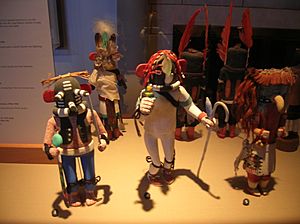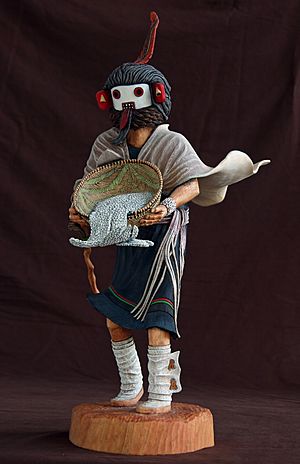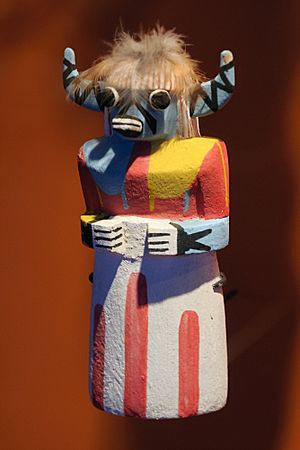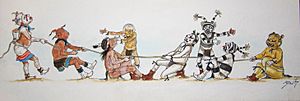Hopi Kachina figure facts for kids
Hopi katsina figures (in Hopi: tithu or katsintithu), also known as kachina dolls, are special figures. The Hopi people carve them, usually from cottonwood tree roots. These figures help teach young girls and new brides about katsinas. Katsinas are spirit beings who bring rain, control nature, and act as messengers between humans and the spirit world.
Contents
What Are Katsina Figures Like?
Different Types of Figures
Katsina figures come in four main types. Each type is made for a different age group as children grow up.
- Putsqatihu – These are flat figures made for babies. They have just enough details to show which katsina they represent.
- Putstihu taywa’yla – These figures have flat bodies but their faces are carved in 3D. They are usually for toddlers.
- Muringputihu – These figures have round bodies and fully carved heads. They are made especially for baby girls.
- Tithu – These are the traditional, full-bodied katsina figures. Hopi girls aged two and older receive them at special ceremonies. They show the final stage of a child's early development.
Today, there are also miniature katsina figures. Hopi women often create these. They are mostly made to be sold and are not always seen as traditional katsina figures.
Faces of the Figures
Katsina figures have different kinds of eyes and mouths.
- Eyes: Some eyes are painted on and can be round, rectangular, or half-moon shapes. Other eyes are carved from wood and then attached to the figure.
- Mouths: Painted mouths can be rectangular, triangular, or crescent-shaped. Carved mouths might be a horizontal line with a beard, a beak pointing up or down, or a short snout.
On the figure's head, you might see bird wings, large red ears, cornhusk flowers, hair, feathers, or horns. The horns can be fake or real animal horns. Noses are usually not very realistic, unless they are carved right into the wood. Some katsinas also have beards made of feathers or red horsehair.
What They Wear
Katsina figures wear many different outfits, called regalia. These outfits often look like what the real katsinas wear during ceremonial dances.
- Male Outfits: Common male outfits include a white skirt (kilt), a special sash, a belt, and a fox skin. Sometimes they wear a white shirt and kilt, or a kilt with a ceremonial robe. Some figures even wear a "white man’s" suit, or a velvet shirt with white pants and red leggings. A fox skin might hang from the belt.
- Female Outfits: Common female outfits include a ceremonial robe worn as a dress with a shawl, or a manta (a type of blanket dress). Some wear an eagle feather skirt, or a black woolen dress with a red belt and a white shawl with red and blue stripes.
Things They Carry
Katsina figures also carry items that the real katsinas would use in dances. These can include rattles made from gourds, bows and arrows, branches of Douglas fir trees, staffs, scissors, or crooks (curved sticks). They might also carry colored corn. Sometimes, the items they carry show what the katsina does. For example, the Cold-Bringing Woman carries a sifter basket of snow. She scatters it to encourage snow, which helps crops grow.
Figures sometimes wear ruffs around their necks to hide the space between the body and the mask. These ruffs can be made of fox skin, juniper branches, Douglas fir, or cloth. Headdresses are also common. These might be maiden-whorls (hair arrangements) on the sides of the head, an eagle feather on the mask, or a tripod of sticks on top of the head.
Colors and Their Meanings
Every symbol, color, and design on a Hopi katsina figure has a special meaning. These meanings connect to Hopi religion, customs, history, and way of life. Animal tracks, bird tracks, and symbols for the sky or plants represent those spirits.
Here are some other symbols and what they mean:
- Two straight lines under the eyes mean a warrior’s footprints.
- An upside-down “V” means certain katsina leaders.
Colors on the figures also have meanings related to directions:
- Yellow = north or northwest
- Blue-green = west or southwest
- Red = south or southeast
- White = east or northeast
- All the colors together = heaven and above
- Black = the underworld or down
How to Spot a Real Katsina Figure
It can be tricky to tell if a katsina figure is real or a fake. A fake one might look "too flashy" or poorly made. A real katsina figure will have body parts that are well-proportioned, and it won't have too many extra details. The hands should have separate fingers, not just closed fists. Details in the hair and accessories should be very carefully made.
The best figures are carved from a single piece of wood. If you see glue on the figure, it might mean it was poorly carved from different pieces. The price often shows the quality. If a figure seems very cheap, it might not be a true Hopi katsina figure.
Popular Katsina Types
There are more than 200 types of katsina figures! It's hard for anyone to know them all, because each carver has their own ideas about how each katsina should look and what it does. However, some types are very popular with both tourists and the Hopi people. Some well-known figures include the Tasapkachina (Navajo Katsina), Angakchina (Long Hair), Hote, and animal figures like the Bear, Bird, and Mouse.
Hopi Clowns
Clowns are also part of Hopi celebrations and sacred rituals. They have two main jobs. Their most obvious job is to make people laugh during outdoor celebrations and Katsina Dances. They act like jesters or circus clowns while the katsina dancers rest. Because people enjoy their humor and funny acts, clown carvings are very popular to sell to tourists and collectors. Carvers enjoy the challenge of making dolls that show the clowns' many silly actions.
The clowns' second, more private job is in the sacred katsina rituals. The Hopi people keep these sacred functions quite secret, so they are not as well known to the public. The Koshare (or Tewa clown) and the Koyemsi (Mud-head) are two of the most popular clown figures.
Images for kids
-
Kachina Doll (Kokopol), from the late 1800s, at the Brooklyn Museum.









